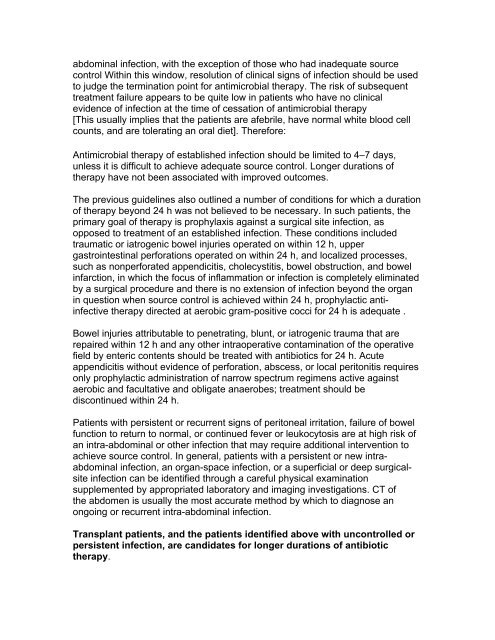Antimicrobial Use Guidelines (AMUG) version 21 - UW Health
Antimicrobial Use Guidelines (AMUG) version 21 - UW Health
Antimicrobial Use Guidelines (AMUG) version 21 - UW Health
Create successful ePaper yourself
Turn your PDF publications into a flip-book with our unique Google optimized e-Paper software.
abdominal infection, with the exception of those who had inadequate sourcecontrol Within this window, resolution of clinical signs of infection should be usedto judge the termination point for antimicrobial therapy. The risk of subsequenttreatment failure appears to be quite low in patients who have no clinicalevidence of infection at the time of cessation of antimicrobial therapy[This usually implies that the patients are afebrile, have normal white blood cellcounts, and are tolerating an oral diet]. Therefore:<strong>Antimicrobial</strong> therapy of established infection should be limited to 4–7 days,unless it is difficult to achieve adequate source control. Longer durations oftherapy have not been associated with improved outcomes.The previous guidelines also outlined a number of conditions for which a durationof therapy beyond 24 h was not believed to be necessary. In such patients, theprimary goal of therapy is prophylaxis against a surgical site infection, asopposed to treatment of an established infection. These conditions includedtraumatic or iatrogenic bowel injuries operated on within 12 h, uppergastrointestinal perforations operated on within 24 h, and localized processes,such as nonperforated appendicitis, cholecystitis, bowel obstruction, and bowelinfarction, in which the focus of inflammation or infection is completely eliminatedby a surgical procedure and there is no extension of infection beyond the organin question when source control is achieved within 24 h, prophylactic antiinfectivetherapy directed at aerobic gram-positive cocci for 24 h is adequate .Bowel injuries attributable to penetrating, blunt, or iatrogenic trauma that arerepaired within 12 h and any other intraoperative contamination of the operativefield by enteric contents should be treated with antibiotics for 24 h. Acuteappendicitis without evidence of perforation, abscess, or local peritonitis requiresonly prophylactic administration of narrow spectrum regimens active againstaerobic and facultative and obligate anaerobes; treatment should bediscontinued within 24 h.Patients with persistent or recurrent signs of peritoneal irritation, failure of bowelfunction to return to normal, or continued fever or leukocytosis are at high risk ofan intra-abdominal or other infection that may require additional intervention toachieve source control. In general, patients with a persistent or new intraabdominalinfection, an organ-space infection, or a superficial or deep surgicalsiteinfection can be identified through a careful physical examinationsupplemented by appropriated laboratory and imaging investigations. CT ofthe abdomen is usually the most accurate method by which to diagnose anongoing or recurrent intra-abdominal infection.Transplant patients, and the patients identified above with uncontrolled orpersistent infection, are candidates for longer durations of antibiotictherapy.
















